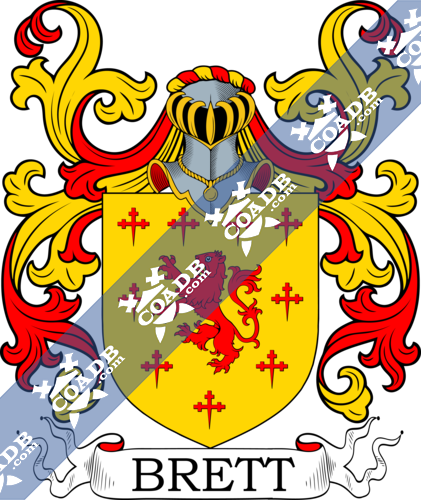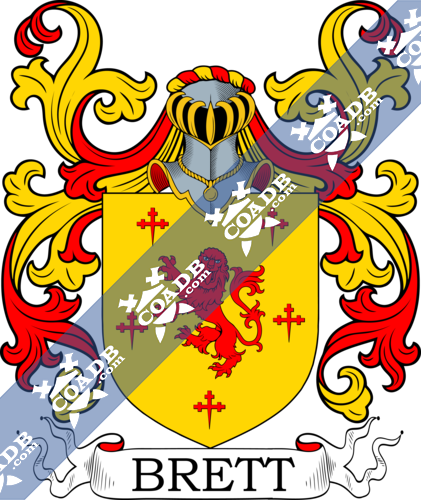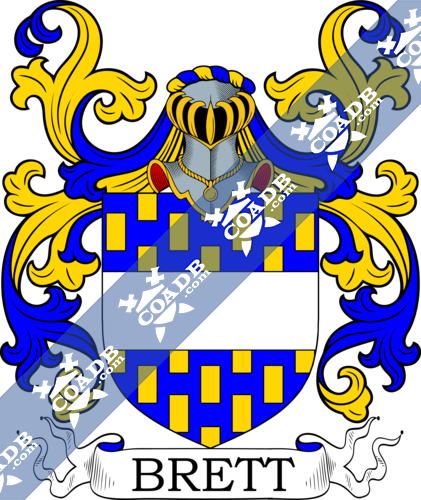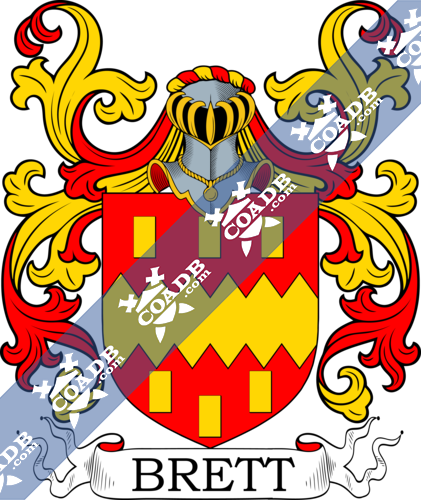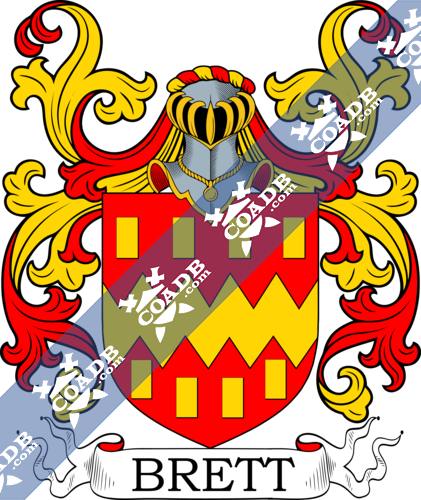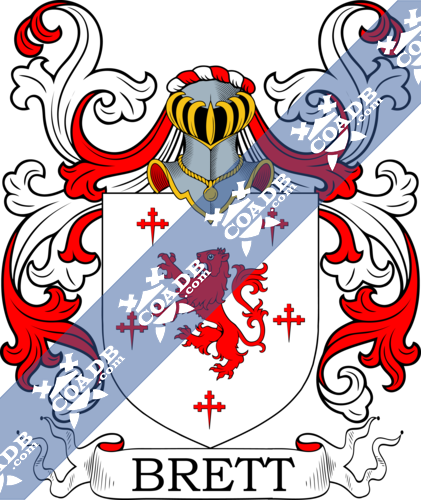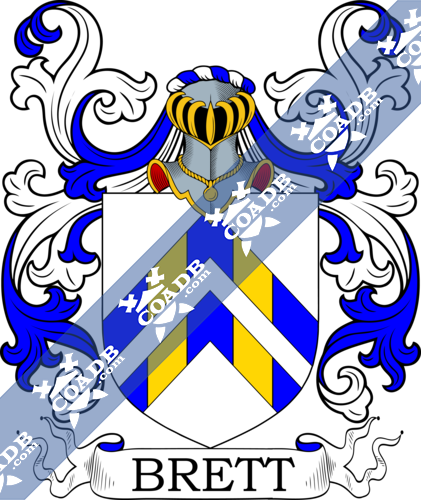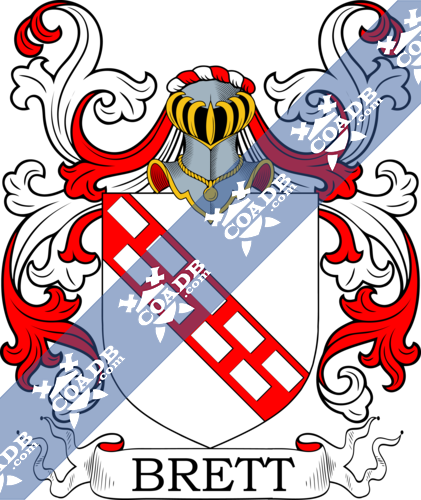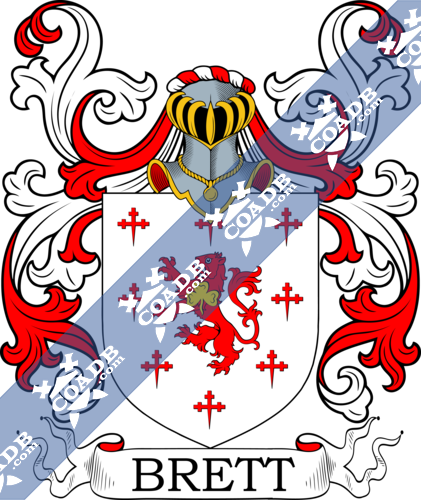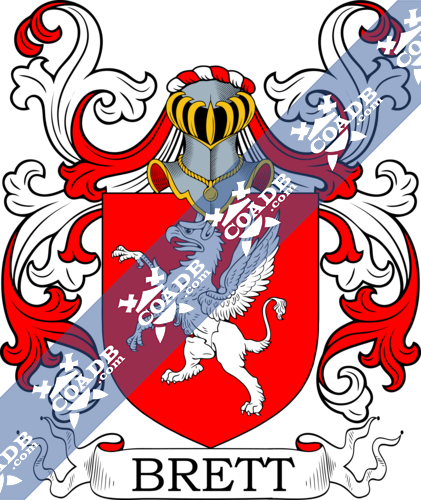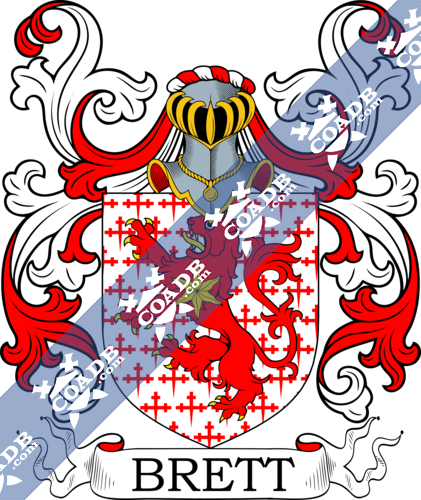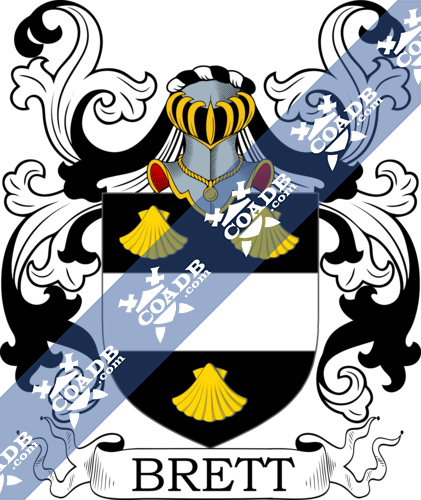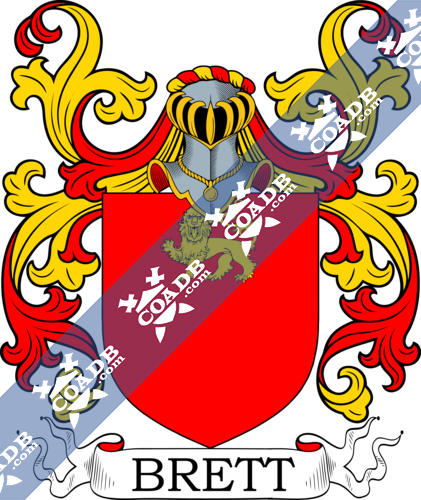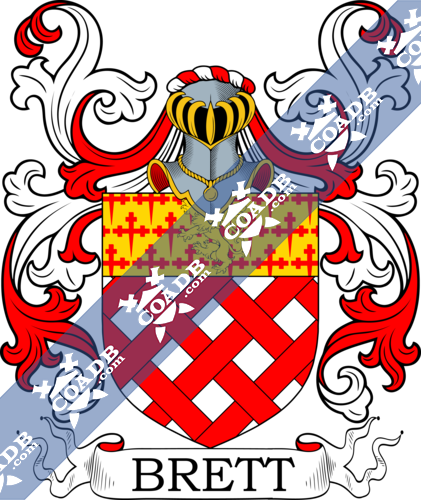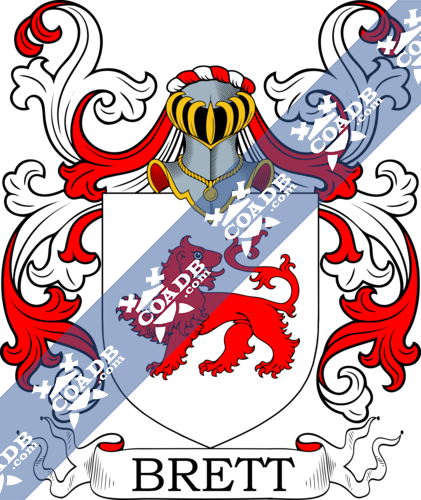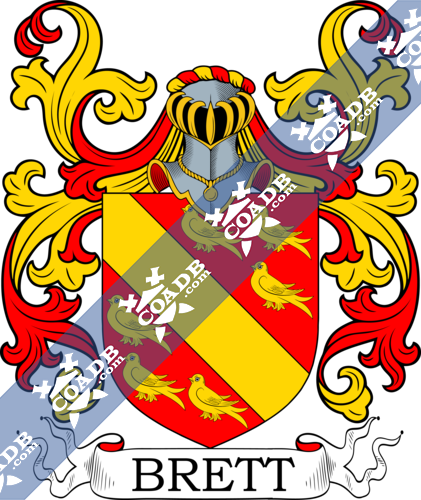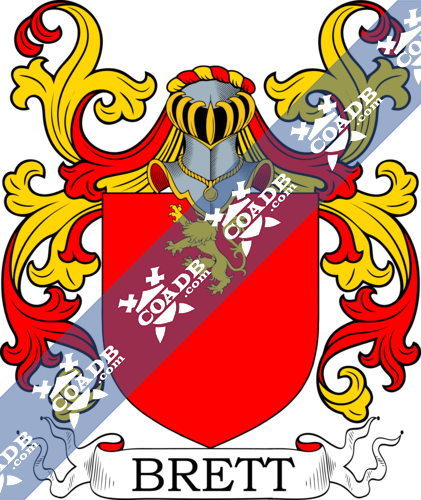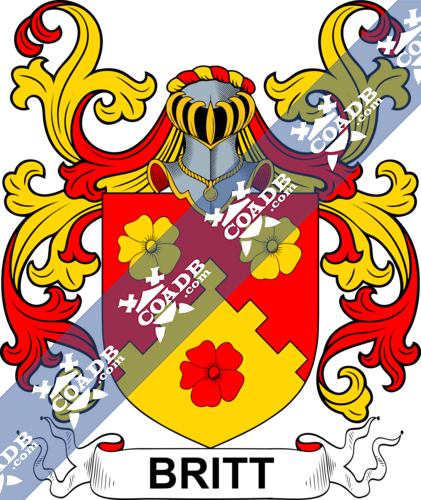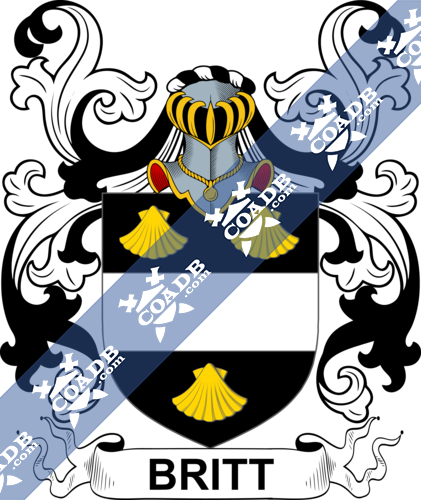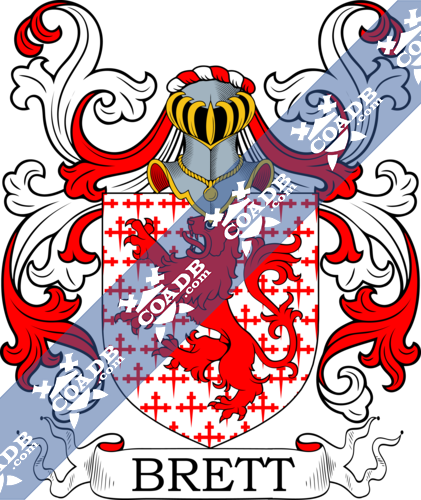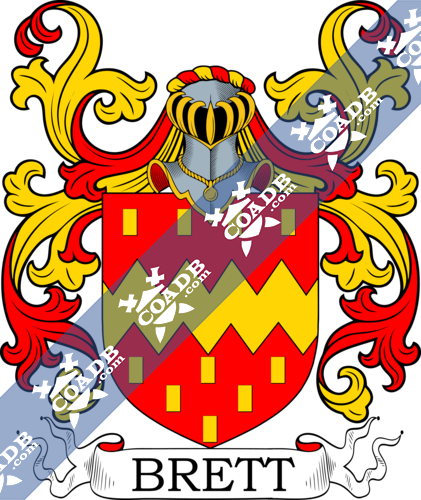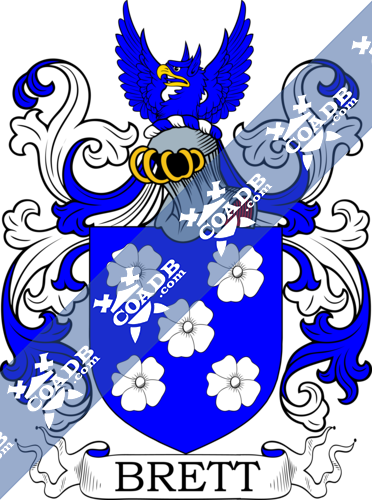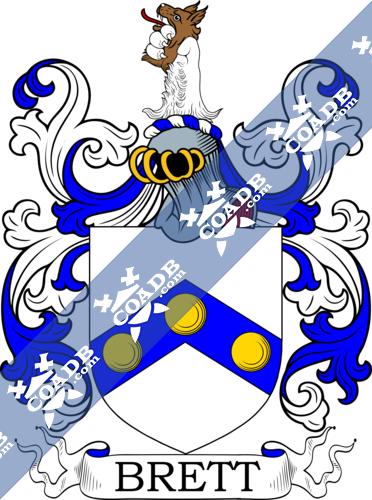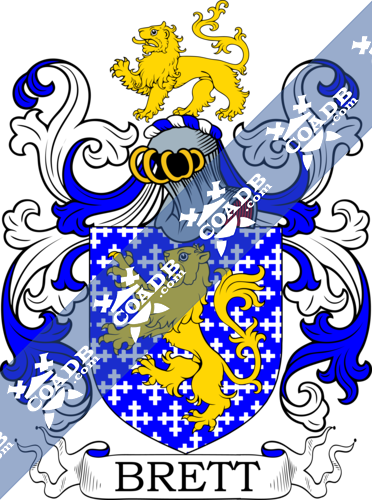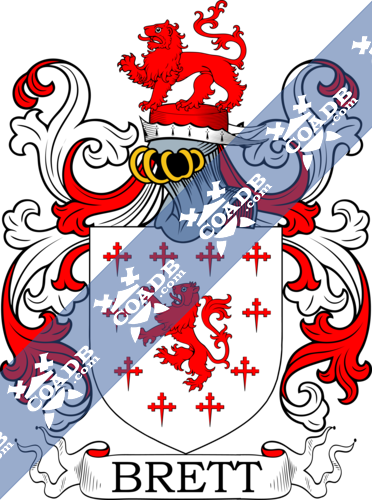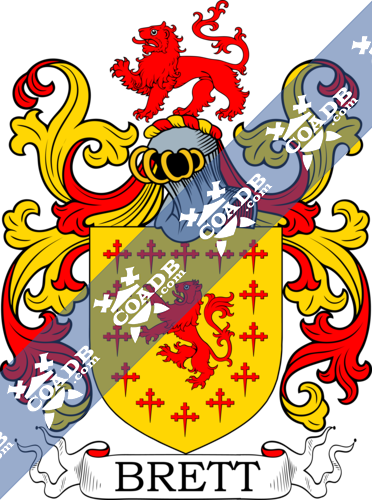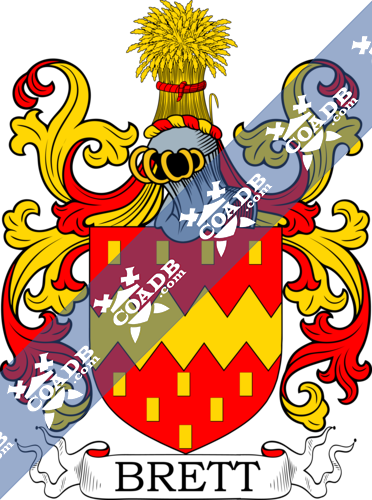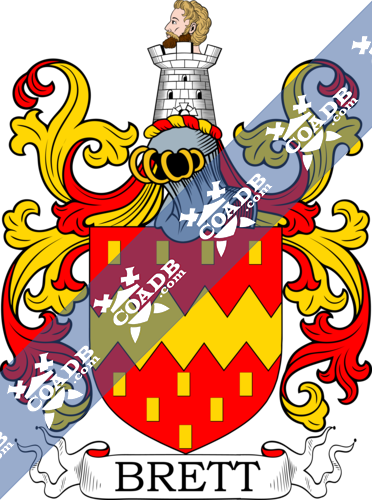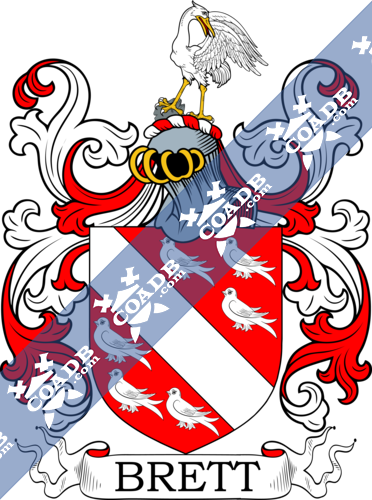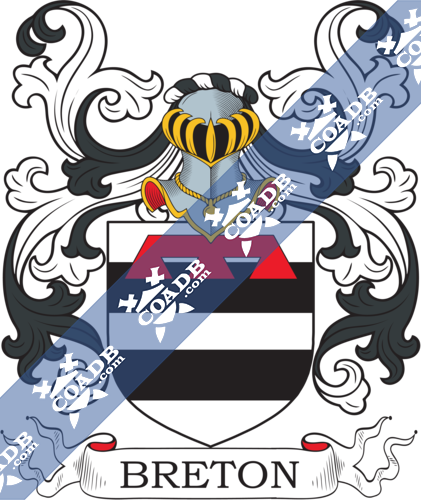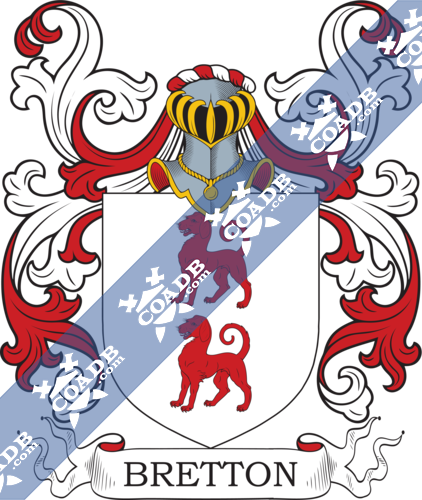Brett Family Crest, Coat of Arms and Name History

Brett Coat of Arms Gallery
Don’t know which Coat of Arms is yours?
We can do a genealogical research. Find out the exact history of your family!
Learn MoreBrett Origin:
France, England, German
Origins of Brett:
The origin of this unique surname evolved originally from France and is a cultural name for a Breton. In the 6th century; the Bretons were initially Celts driven from South West England to North West France by the attack of Anglo-Saxons. Some returned with the army of William the Conqueror in the year 1066, and many of those then settled in East Anglia where the surname Brett is now spread widely. Periodically, the name may develop from Strathclyde, Scotland, where people were speaking the Celtic language, who were recognized as “Bryttas” or “Brettas” till the 13th Century. According to the early recordings in London, William Brett married Johanna Hayward in the year 1559; in Norfolk, Richard Brett, married Elizabeth Leive on 23rd September 1552, at Church of St. George’s, Colegate, Norwich. A Coat of weapons gifted to a Brett family is silver, three bezants on a blue chevron. The developmental names included Britt, Breton, Bretton and De Brett (of Breton).
Variations:
More common variations are: Barett, Bryett, Burett, Breatt, Brette, Bruett, Breett, Bretti, Bretto, Bretta.
England:
The origins of the surname Brett were in Somerset at Samford Brett, an area when it was simply registered as Sanford. In the year 1306, the village known as Saunford Bret was founded. It was the time of King Hugo Brito, son of Simon le Bret or Simon Brito, one of the four noble persons who killed a religious man Thomas Becket in the year 1170. In Dorest, in the Church of Holwell, other people with surname can be found.
The very first recording spelling of the family was shown to be that of Edward Brit, dated 1086, in the Domesday document of Devon. It was during the time of King William I, who was known to be the “The Conqueror,” 1066 – 1087.” The origin of surnames during this period became a necessity with the introduction of personal taxation. It came to be known as Poll Tax in England. Surnames all over the country began to develop, with unique and shocking spelling varieties of the original one.
Ireland:
People of Brett also moved to Ireland in the 7th century.
United States of America:
People with the Brett surname also settled in the United States in three different centuries respectively in the 17th and 18th and 19th. Individuals who settled in the 17th Century included Isabel Brett in Salem, Massachusetts in 1630. James Brett settled in Barbados in 1635. Alex Brett in Virginia in 1638 and William Brett landed in New-Zealand in 1645.
The following century saw much more Brett surnames arrive. People of Brett, who came in the 18th century included Susanna Brett, John Brett, and Timothy Brett arrived in Virginia respectively in the years 1711, 1714 and 1719. Matthias Brett landed in Boston, Massachusetts in 1766.
People with the Brett surname who arrived in the 19th century included many people like Robert R Brett, at the age of 53, Edmund Brett, aged 37, Martin Brett, and Richard Brett landed in New York, NY respectively in the years 1806, 1812,1817 and 1854. R S Brett in San Francisco, California in the year 1851.
Canada:
People of Brett family who settled in Canada in the 18th century included Hanah, James, Peter and Phoebe Brett arrived in Nova Scotia in the year 1750.
Australia:
Some of the Brett people who settled ultimately in the 19th century in Australia included William Brett, an English prisoner from Middlesex, aboard the ship “Asia” on 3rd September 1820 in New South Wales, Australia. William Arthur Brett, an English prisoner from Essex, also aboard the ship “Arab” on 3rd July 1822, landed in Van Diemen’s Land, Australia. Cass Brett in Adelaide, Australia aboard the ship “Susannah” in 1849. Charles Brett, at the age of 60 and Alice Brett, aged 55, came in Adelaide, Australia aboard the ship “Sultana” in the year 1851.
Here is the population distribution of the last name Brett: United States 7,376; England 9,803; Australia 3,298; Ireland 1,359; Canada 2,293; South Africa 2,685; India 609; Pakistan 1,006; New Zealand 648; Venezuela 2,358
Notable People:
Brian Brett (1950), was a Canadian author.
Charles Brett (1928–2005), was a Northern Irish lawman
Jeremy Brett (1933–1995), was a British artist
Jodie Brett was an English football player
Laurie Brett (1970), was a British artist and entertainer
Peter V. Brett (1973), was an American author of dream novels
Raymond L. Brett (1917–1996), was a teacher of English and a fellow of Philip Larkin
Reginald Brett, 2nd Viscount Esher (1852–1930), was a British politician
Richard Brett (1567–1637), was an English professor
Blazons & Genealogy Notes
1) (Brecknockshire). Per chev. embattled gu. and or. three cinquefoils counterchanged.
2) (Cornwall). Ar. two chev. az. on each as many pales or.
3) (Devonshire). Ar. fretty gu. on a chief or, semee of crosses crosslet fitchee of the second, a lion ramp. of the last.
4) (Devonshire and Kent). Or, a lion ramp. within an orle of crosses crosslet fitchee gu. Crest—A lion pass. gu.
5) (Whitstanton, co. Devon, Visit. London, 1568). Ar. semee of cross crosslets fitchee a lion ramp. gu.
6) (Wiverton, co. Nottingham, Visit. 1569 and 1614). (Wapinthorne, co. Essex). Gu. a fesse dancettee betw. ten billets or, four in chief, three, two, and one in base.
7) (Tisters, Wakes, Colne, co. Essex). Motto—Velis id quod possis. Same Arms. Crest—A garb.
8) (Gloucestershire and Leicestershire). Same Arms. Crest—On a tower ar. a man’s head ppr.
9) (Ireland). Gu. a bend betw. six martlets ar. Crest—A crane reguard. wings endorsed, resting the dexter foot on a stone.
10) (Sir William Brett, K.C.M.G., Denbigh House, co. Kent). Or, a lion ramp. betw. nine cross crosslets fitchee gu.
11) (Kent). Az. five cinquefoils in saltire ar. Crest—A griffin’s head betw. two wings expanded az. beaked or.
12) (Kent). Or, a lion ramp. guard. betw. five crosses crosslet fitchee gu.
13) (Tinsley, Rotherham). Az. billettee or, a fesse ar.
14) (Rotherby, co. Leicester, Visit. 1619). Gu a fesse indented betw. six billets or.
15) (Leicestershire). Gu. a fesse dancettee betw. eight billets or, four and four (another, twelve billets).
16) (Somersetshire). Ar. a lion ramp. betw. five (another, nine) crosses crosslet fitchee gu.
17) (Staffordshire). Ar. on a chev. az. three bezants. Crest—A lion’s gamb erect and erased ar. grasping a wolf;s head erased ppr. (another, a dragon’s vert).
18) Az. semee of crosses crosslet ar. a lion ramp. or. Crest—A lion pass. or.
19) Or, a lion ramp. within an orle of crosses crosslet gu. Crest—A lion pass. gu.
20) Ar. on a bend gu. nine billets, fire and four of the first.
21) Ar. a lion ramp. gu. charged on the shoulder with a trefoil slipped or, betw. eight (another, ten) crosses crosslet fitchee of the second.
22) Az. flory ar. a lion ramp. reguard. of the second on the shoulder a mullet, over all a bend gu.
23) (Hon. Sir William Baliol Brett, one of the Justices of the Court of Common Pleas). Quarterly, 1st and 4th, or, crusily fitchee gu. a lion ramp. of the second, for Brett; 2nd, per pale or and gu. three leopards’ faces counterchanged, for Wilford; 3rd, az. three bears’ heads couped ar. muzzled gu., for Forbes. Crest—A lion pass. gu.
24) Gu. a griffin segreant ar.
25) Or, three piles az.
26) Ar. crusilly fitchee gu. a lion ramp. of the second (on his shoulder an estoile) armed and langued or.
27) Sa. a fesse ar. betw. three escallops or.
28) (Ocle Court, near Hereford). Ar. a lion ramp. betw. ten crosses crosslet fitchee gu. Crest—On a cap of maintenance turned up erm. a lion pass. gu.
29) Gu. in chief a lion pass. guard. (another, reguard.) or.
30) (South Maperton). Ar. a lion pass. reguard. gu.
31) Gu. a bend betw. six martlets or.
32) Gu. in chief a lion ramp. or.
33) (Brecknockshire). Per chev. embattled gu. and or. three cinquefoils counterchanged.
34) (Devonshire). Sa. a fesse ar. (another, or) betw. three escallops or.

